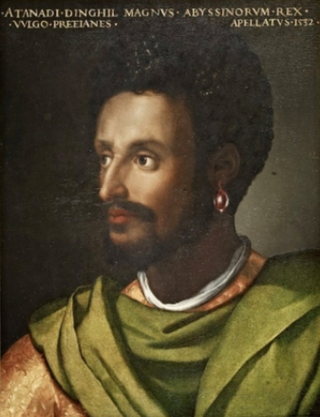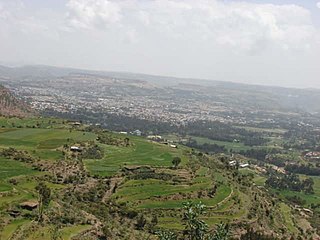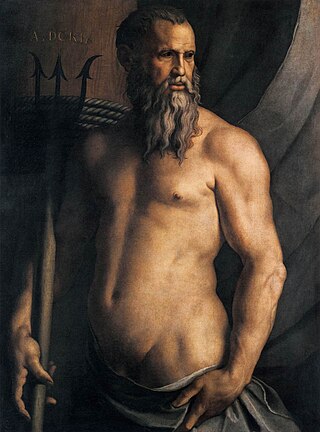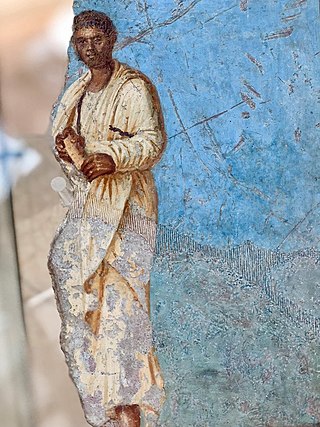Alchitrof is the name of a 1568 painting by Cristofano dell'Altissimo that depicts an Aethiopian king.
Contents

Alchitrof is the name of a 1568 painting by Cristofano dell'Altissimo that depicts an Aethiopian king.

16th century Italian historian and biographer Paolo Giovio (1483–1552) assembled a series of 484 portraits, known as the Giovio Series. These portraits included, but where not limited to, rulers, statesmen and literary figures. Much of the original collection is now lost, but it is preserved in a series of at least 280 copies made by the Italian painter Cristofano dell'Altissimo (c. 1525–1605). From the surviving copies by Cristifano, two portraits are of Ethiopian monarchs. The first of these was of Emperor Lebna Dengel (r. 1508–1540) while the other was of a king named "Alchitrof".
Alchitrof is not named in any Ethiopian regnal lists. The portrait of Alchitrof includes a feathered headdress and three rings on his lower lip, features which do not match with what is known about Ethiopian custom and culture during the period when the portrait was painted. It is possible that "Alchitrof" is not meant to be real person but rather "a fantastic approach" from a European perspective. [1]
Kate Lowe, a professor of Renaissance history, suggested that the name "Alchitrof" may be a corruption of the name of Lebna Dengel's eldest son al-Fiqtur. [2] Lowe also suggested there may be a "mismatch" between the image and its inscription, as the clothing and jewellery are often used in reference to South America rather than Sub-Saharan Africa in Renaissance art. [2] Additionally, Lowe argued that "Achitrof" may be an "imagined Brazilian, Carib or Amerindian chief or ruler" with his facial features being inspired by "more realistic physiognomic features taken from black Africans in Europe". [3]
Alternatively, Alchitrof may not have been a king in the modern-day territory of Ethiopia, but rather that the term "Aethiopia" that is used refers to a more generalized region covering much of Sub-Saharan Africa and thus Alchitrof, if he existed, may have been king of a totally different geographical region to that of Lebna Dengel. The modern-day region of Ethiopia was frequently called "Abyssinia" by the Europeans at the time the painting was made and the painting of Lebna Dengel specifically calls him the "Great King of the Abyssinians" instead of "Aethiopia" as used in the portrait of Alchitrof, suggesting that the original artist (or copier) deliberately chose to differentiate their regions of rule. Dr. Emil Krén and Dr. Daniel Marx suggested that Alchitrof did not look "Ethiopian" because Aethiopia extended into modern-day Tanzania. [4]

A portrait is a painting, photograph, sculpture, or other artistic representation of a person, in which the face and its expressions are predominant. The intent is to display the likeness, personality, and even the mood of the person. For this reason, in photography a portrait is generally not a snapshot, but a composed image of a person in a still position. A portrait often shows a person looking directly at the painter or photographer, in order to most successfully engage the subject with the viewer.

The Adal Sultanate also known as the Adal Empire, or Bar Saʿad dīn was a medieval Sunni Muslim Empire which was located in the Horn of Africa. It was founded by Sabr ad-Din III on the Harar plateau in Adal after the fall of the Sultanate of Ifat. The kingdom flourished c. 1415 to 1577. At its height, the polity under Sultan Badlay controlled the territory stretching from Cape Guardafui in Somalia to the port city of Suakin in Sudan. The Adal Empire maintained a robust commercial and political relationship with the Ottoman Empire. Sultanate of Adal was alternatively known as the federation of Zeila.

Francesco del Cossa was an Italian Renaissance painter of the School of Ferrara, who after 1470 worked in Bologna. Cossa is best known for his frescoes, especially his collaboration with Cosimo Tura on a cycle of the months in the Palazzo Schifanoia of the Este family, rulers of Ferrara. Otherwise, his paintings are mostly of religious subjects, with some portraits and drawings attributed to him. He also designed stained glass.

Wollo was a historical province of northern Ethiopia. During the Middle Ages this province name was Bete Amhara and it was the centre of the Solomonic emperors. Bete Amhara had an illustrious place in Ethiopian political and cultural history. It was the center of the Solomonic Dynasty established by Emperor Yekuno Amlak around Lake Hayq in 1270. Bete Amhara was bounded on the west by the Abbay, on the south by the river Wanchet, on the north by the Bashilo River and on the east by the Escarpment that separate it from the Afar Desert.

Dawit II, also known by the macaronic name Wanag Segad, better known by his birth name Lebna Dengel, was Emperor of Ethiopia from 1508 to 1540, whose political center and palace was in Shewa.

Agame was a former province in northern Ethiopia. It includes the northeastern corner of the Ethiopian Empire, borders in Eritrea, Tembien, Kalatta Awlalo and Enderta in the south, and both the Eritrean and Ethiopian Afar lowlands in the east. This relative location of Agame is at the strategic crossroads between the Red Sea and the northern Tigrayan plateau on the other. In pre-1991, Agame had a total area of about 4,889 square kilometres (1,888 sq mi) with an estimated population of 344,800.

Ancient Aethiopia, first appears as a geographical term in classical documents in reference to the upper Nile region of Sudan, areas south of the Sahara, and certain areas in Asia. Its earliest mention is in the works of Homer: twice in the Iliad, and three times in the Odyssey. The Greek historian Herodotus uses the appellation to refer to such parts of sub-Saharan Africa as were then known within the inhabitable world.

Major Sir William Cornwallis Harris was an English military engineer, artist and hunter.

Lowe Art Museum is the art museum of the University of Miami in Coral Gables, Florida. The museum is located on the campus of the University of Miami and is accessible by Miami Metrorail at University Station.

The Giovio Series, also known as the Giovio Collection or Giovio Portraits, is a series of 484 portraits assembled by the 16th-century Italian Renaissance historian and biographer Paolo Giovio. It includes portraits of literary figures, rulers, statesmen and other dignitaries, many of which were done from life. Intended by Giovio as a public archive of famous men, the collection was originally housed in a specially-built museum on the shore of Lake Como. Although the original collection has not survived intact, a set of copies made for Cosimo I de' Medici now has a permanent home in Florence's Uffizi Gallery.
Saga za Ab, often known in contemporary Europe as Sagazabo or Zaga Zabo, was an Ethiopian ambassador who visited Europe in 1527–33. Saga za Ab was sent to Portugal by the Ethiopian king Lebna Dengel in 1527. He accompanied a Portuguese mission to Ethiopia led by Francisco Álvares, which had been sent in 1520 by the king of Portugal following a 1507 request for help by Queen Eleni of Ethiopia against the Muslims in the Red Sea. The mission returned to Portugal in 1527. Saga za Ab was interrogated quite harshly by Iberian religious authorities Diogo Ortiz de Villegas and Pedro Margalho about what was perceived as Ethiopian "deviations" from the Christian faith, especially the Sabbath and circumcision, leading to accusations of Ethiopians being Judaeos and Mahometanos, but he courageously endeavoured to defend his creed.
Cristofano dell'Altissimo was an Italian painter in Florence.

The Lucan portrait of Leonardo da Vinci is a late 15th- or early 16th-century portrait of a man that was discovered in 2008 in a cupboard of a private house in Italy.

Medri Bahri, also known as Midri Bahr, Medre Bahr, Bahr Melash or The territory of the Bahr Negash was an Eritrean semi-autonomous Kingdom located in modern day Eritrea and some surrounding areas. The kingdom emerged in 1137 when Emperor Zara Yaqob reorganized the northern highlands into one administration under a Bahr Negash.

The Portrait of Andrea Doria as Neptune is an oil painting on canvas completed by Bronzino for a private collection in either the 1530s or 1540s. It is now in the Pinacoteca di Brera in Milan, Italy. An oil painting on canvas, it measures 199.5 centimetres (78.5 in) by 149 centimetres (59 in). In a conscious revival of the convention in classical sculpture of showing important political figures in heroic nudity, it depicts the Genoan admiral, Andrea Doria, posing as the classical god of the sea, Neptune.

In classical antiquity, Greek and Roman writers were acquainted with people of every skin tone from very pale to very dark (associated with populations from sub-Saharan Africa. People described with words meaning "black", or as Aethiopes, are occasionally mentioned throughout the Empire in surviving writings, and people with very dark skin tones and tightly-curled hair are depicted in various artistic modes. Other words for people with other skin tones were also used.

An equestrian portrait is a portrait that shows the subject on horseback. Equestrian portraits suggest a high-status sitter, who in many cases was a monarch or other member of the nobility, and the portraits can also carry a suggestion of chivalry.
Seble Wongel was Empress of Ethiopia through her marriage to Lebna Dengel. She is well-known as a key political and military figure during the Ethiopian–Adal War, as well as the reigns of her sons and grandson.
Lemma Guya Gemeda (1928–2020), was Ethiopian painter, airplane pilot, and author. He created some ten-thousand of his original artworks, and used goat skin for painting portraits.
The 1922 regnal list of Ethiopia is an official regnal list that was provided by Ethiopian prince regent Tafari Makonnen which names over 300 monarchs across six millennia. The regnal list is partially inspired by older regnal lists of Ethiopia and chronicles. The 1922 regnal list however includes many additional names that allude to ancient Nubia, which was known as Aethiopia in ancient times, and various figures from Greek mythology and the Biblical canon that were known to be "Aethiopian".